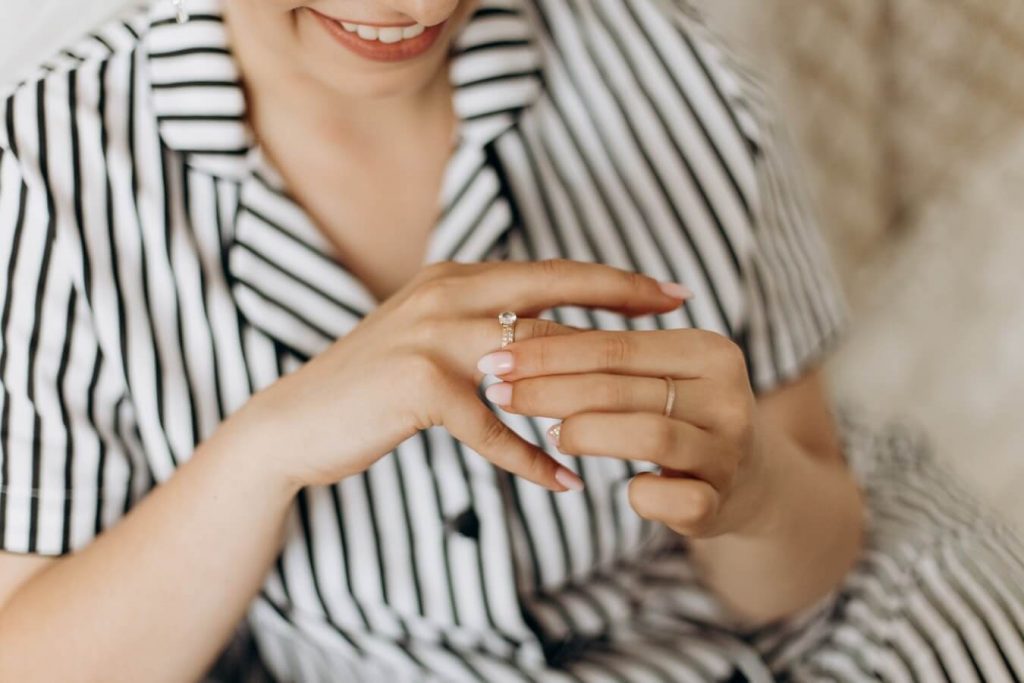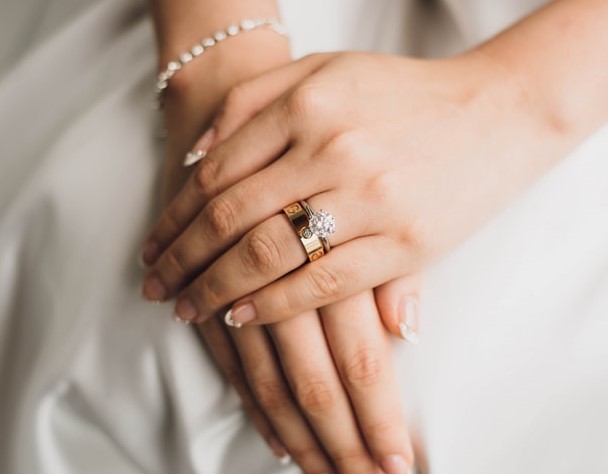As Wedding Know How editors, we write about things that we love and we think you'll like too. We have affiliate partnerships and sponsorship and may generate some revenue from these at no cost to you.
Contents
- Rule #1 – Wedding Ring Goes on First
- How to Break
this Rule:
- How to Break
- Rule #2 – You Have to Have Both and Engagement
and a Wedding Ring- How to Break
this Rule:
- How to Break
- Rule #3 – The Engagement, Wedding and Groom’s Rings
Have to Match- How to Break
this Rule:
- How to Break
- Rule #4 – You Should Only Wear One Wedding Band
- How to Break
this Rule:
- How to Break
- Rule #5 – Yours Rings Have to Be Made of Metal
- How to Break
this Rule:
- How to Break
- Rule #6 – Your Engagement Ring Should Have a
Diamond- How to Break
this Rule:
- How to Break
We don’t like the word rules when it comes to jewelry,
because fashion and beauty is subjective. Restrictions, stereotypes and
traditions can stifle your creativity and keep you from expressing yourself.

However, whether you like it or not, there are some
generally accepted guidelines and certain etiquette surrounding the wearing of
engagement rings and wedding bands.
But there are also ways to break these guidelines.
Whether you choose to follow these rules or to create
your own trend is entirely up to you. Let’s take a look at some of the ‘rules’
that are associated with bridal rings and ways to ‘break’ the rule.
Rule #1 – Wedding Ring Goes on First
There are specific rules
regarding wearing your engagement and wedding rings on your finger:
- Before the wedding – the engagement ring is worn on the ring finger of
the left hand, chosen because the Romans believed that the ‘vena amoris’
or vein of love ran from that finger to your heart. Science has proven that
there is no such vein and the Romans dreamt it up, but it’s now become tradition
to wear the ring on that finger and no one really questions it. - On your wedding day – the engagement ring is moved to the ring finger
on your right hand until the ceremony, making room for your wedding ring to go
on first. - After you’re married – once the wedding ring is place on your ring
finger (fourth finger of the left hand) the engagement ring is placed above the
wedding ring. Because the wedding ring is the most important ring of the two,
it needs to be nearer to your heart.
How to Break
this Rule:

First, you can choose to wear your rings on any finger
you choose, as there isn’t a wedding ring police to make sure you’re doing it
‘right’.
Some brides choose to wear only the wedding ring on
their vena amoris finger and the engagement ring on their right hand.
Others prefer to wear just the wedding ring, keeping
the engagement ring for special occasions (if they have one).
Another option is to weld the two rings together to
create one unified ring.
Rule #2 – You Have to Have Both and Engagement
and a Wedding Ring
Tradition dictates that you need to have two rings –
an engagement ring and a separate wedding ring. This is because your engagement
ring is given first during the proposal and is a symbol of your commitment and
unavailability. You’re off the shelf, so to speak. The wedding ring then
solidifies this commitment and becomes an exchange between you and your
partner. Both of you are now off the shelf. Although this might seem like a
very old rule, it’s only been around for a while, made more prominent by clever
marketing from the diamond industry.
How to Break
this Rule:

Choose an all-in-one ring, or one ring to do both
jobs. An all-in-one ring is a more economical option and it’s also more comfortable,
especially for people who don’t like wearing rings.
There are many design options that are perfect for this style of ring. You can opt to choose a single ring that features two separate elements like this twisted pave wedding ring or a diamond engagement ring like this one with an eternity band that incorporates the two popular elements of engagement and wedding rings – diamonds and eternity bands.
Rule #3 – The Engagement, Wedding and Groom’s Rings
Have to Match
Trawl on online forums and you’ll see endless threads of brides worrying about how to match their wedding and engagement rings to each other and to the groom’s ring. What many prefer to do is to choose a trio wedding ring set like this gold set, where all three rings have been designed to match.
There’s nothing wrong with
this and it’s perfectly fine if that’s the look you love. But some people don’t
like the matchy matchy look and yet feel compelled to buy matching rings simply
because tradition dictates this.
How to Break
this Rule:

Choose completely different
rings from each other because more likely than not, you and your partner have
different tastes in jewelry and may prefer very different things. He might be a
black ceramic ring kind of guy and you might be in love with yellow gold. So be
it.
What you can do, however, is
to find rings that complement each other without being completely matching.
Think similar finishes but different metal colors or vice versa.
Also, pick engagement and
wedding rings that are different but may have some similar elements that tie
the look together.
Rule #4 – You Should Only Wear One Wedding Band
Since the time the ancient Egyptians began to wear
rings fashioned out of reeds, several thousand years ago, the idea was that
only one ring should be worn for your wedding ring. The ring was symbolic of
the commitment between the couple and when the ring was worn, there was no
mistaking what it was. It’s believed that the wedding ring should never be
taken off but should be worn all the time.
How to Break
this Rule:

Stackable wedding rings by Jadorelli.
This rule is being blown out of the water with the
current trend of stacking wedding rings. Here, instead of wearing one, you can
opt to wear 2 or more wedding rings on your ring finger, creating a modern,
fashionable wedding ring stack. The reason this trend is being embraced by many
women is that it gives women the opportunity to mix fashion with commitment,
and to truly express themselves. Most jewelry retailers offer stacked wedding
band options. How you want to create the stack depends totally on you.
Rule #5 – Yours Rings Have to Be Made of Metal
Although the early Egyptians used reed for their wedding rings, metal became the material of choice due to its durability and strength, another symbol of the couple’s commitment. Traditionally, gold, silver and platinum have been used for wedding rings, with platinum being the most prestigious and gold being the most popular. Even though many alternative metals for wedding rings have entered the market today, like tungsten, titanium, cobalt or tantalum, they still remain metal.
How to Break
this Rule:

Black silicone wedding band. See it here.
There are many different materials available
today that aren’t metal but are used for wedding rings. These include wood,
ceramic, silicone and resin. These materials offer many benefits to the
wearers, including being non-conductive, safer and more comfortable to wear as
well as stylish and modern.
Rule #6 – Your Engagement Ring Should Have a
Diamond
The first diamond engagement
ring that we know of was given by the Archduke Maximilian of Austria to his
beloved Mary of Burgundy in 1477. Diamonds have always been valued for their
extreme strength and sparkle, but they were not the only gemstone used for
engagement rings. This tradition properly began in the 1930s with the de Beer’s
intense marketing campaigns that outlined diamonds as the only gemstone for
engagement rings. Since then, this view has entered the general consciousness
and now diamonds have become the number one choice for couples getting engaged.
How to Break
this Rule:

Gemstone engagement ring featuring blue topaz. See it here.
First of all, engagement
rings don’t need a gemstone because whatever you choose goes. Second, diamonds
aren’t the only gemstone for engagement rings: there’s a world of gemstones to
choose from out there. Of course, not every gemstone works for engagement
rings. You have to consider the durability and wearability of the stone, but
even so, there’s still a lot of choice.
Some excellent options
include ruby, sapphire, emeralds, morganite, peridot, aquamarine and topaz.
These stones each have their pros and cons but can be worn daily.
So there you have it, some
engagement band and wedding ring rules and how to break them to suit your style
and preferences!

You may also like

A Guide to Green Gold – All You Need to Know

What on Earth Are Meteorite Rings?

Wedding Ceremony Ideas to Make Your Wedding Fun and Unique

Different Colors of Gold and How to Choose
Ten articles before and after
Bronze Wedding Bands – Buy or Avoid? | Wedding KnowHow | CHURINGA WEDDING RINGS
Brass Wedding Rings and Bands – Should I Buy or Avoid? | Wedding KnowHow | CHURINGA WEDDING RINGS
Choosing Not to Wear Your Wedding Ring | Wedding KnowHow | CHURINGA WEDDING RINGS
Tungsten vs. Tungsten Carbide for Your Ring | Wedding KnowHow | CHURINGA WEDDING RINGS
Titanium vs. Tungsten – Which is better for a Ring? | Wedding KnowHow | CHURINGA WEDDING RINGS
Chevron Wedding Rings – What Do They Mean? | Wedding KnowHow | CHURINGA WEDDING RINGS
The Pros and Cons of Tungsten Wedding Bands | Wedding KnowHow | CHURINGA WEDDING RINGS
Carbon Fiber Wedding Rings and Bands – A Quick Guide | Wedding KnowHow | CHURINGA WEDDING RINGS
White Gold vs. Platinum for Rings | Wedding KnowHow | CHURINGA WEDDING RINGS
Platinum vs. Titanium for Rings | Wedding KnowHow | CHURINGA WEDDING RINGS